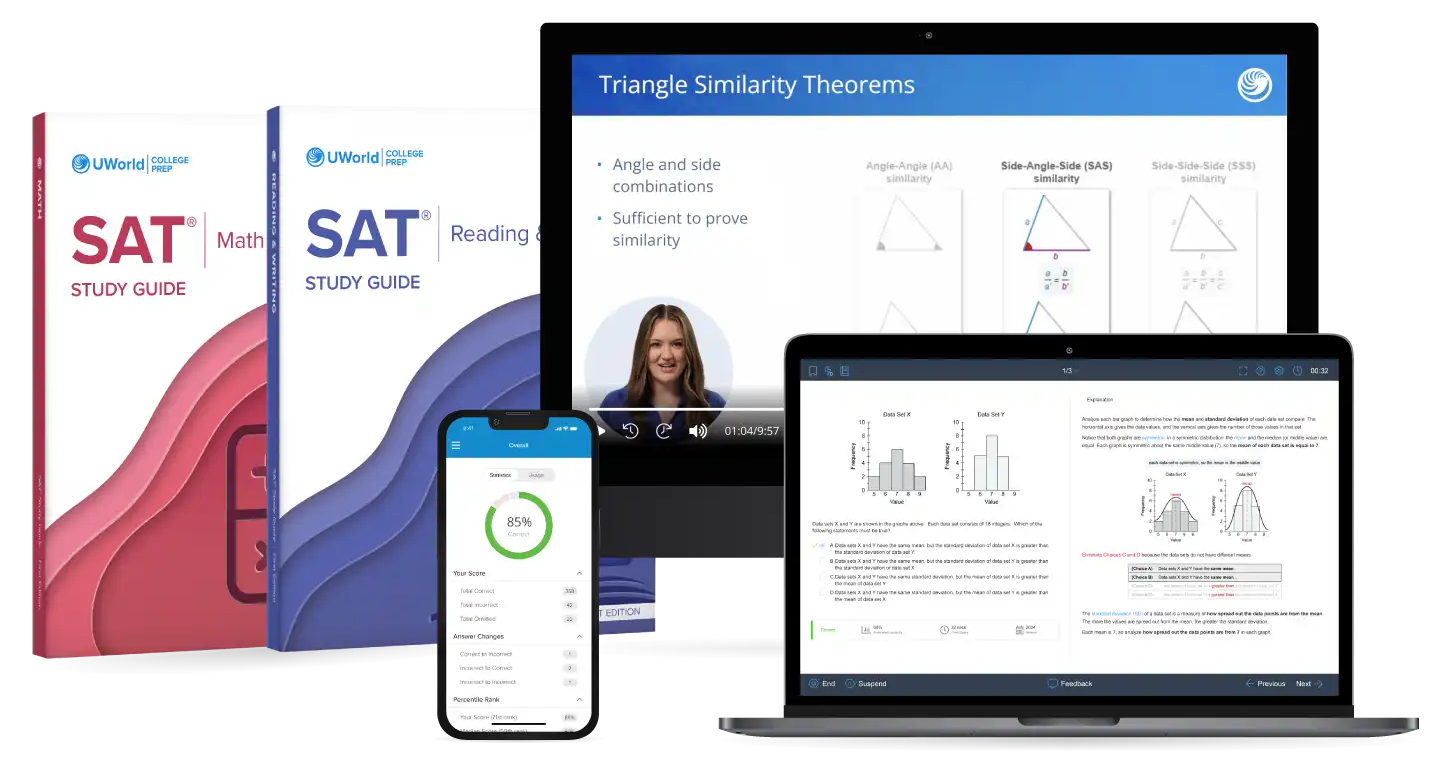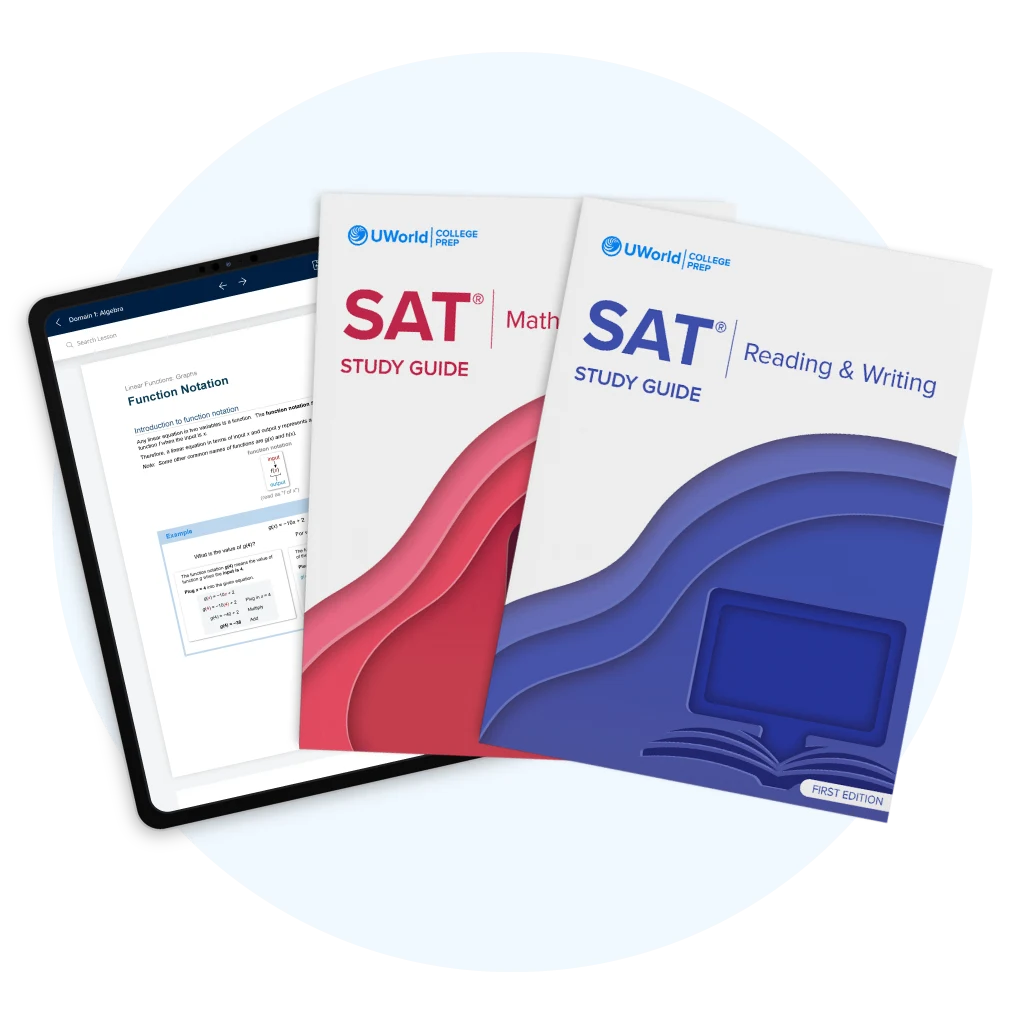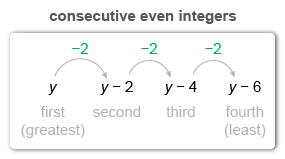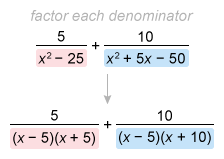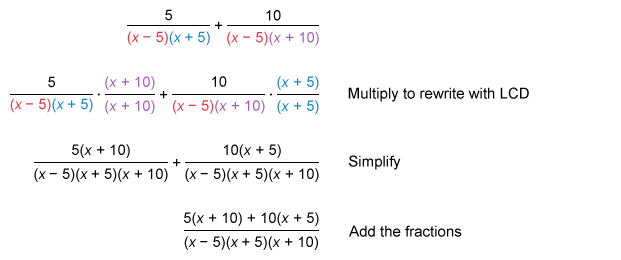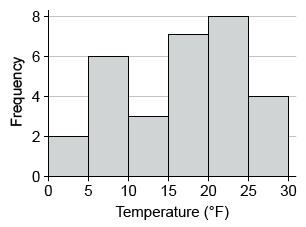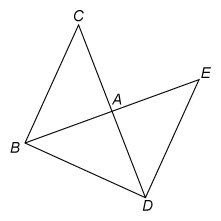SAT® Prep Course
UWorld's online SAT® Prep Course makes mastering tough concepts simple, especially for math.
With review modules containing engaging video lessons, an interactive SAT prep book, and exam-style practice questions, you'll build the skills and confidence to raise your score. Many students have improved by 300+ points in just one month.
You can use it as a summer course, crash course, or full review course.
SAT® Prep Course
UWorld's online SAT® Prep Course makes mastering tough concepts simple, especially for math.
With review modules containing engaging video lessons, an interactive SAT prep book, and exam-style practice questions, you'll build the skills and confidence to raise your score. Many students have improved by 300+ points in just one month.
You can use it as a summer course, crash course, or full review course.
Your Personal Path to a Higher SAT Score
Stop guessing what to study. Our course provides a clear framework designed for one purpose: efficient results. We help you pinpoint your starting score, build a flexible study schedule, and start improving instantly. It’s effective, structured, and built to fit your life.
Establish Your
Baseline Score
Organize Your SAT Study Schedule
Start Improving
Immediately
Our Proven 3-Step Method to Boost Your Confidence & Score
Our all-in-one online SAT prep course and SAT review combine an illustrated study guide, engaging SAT prep videos, and expertly crafted practice questions with detailed explanations - everything you need for a complete SAT review.
Engaging Video Lessons
Our quick, focused SAT videos make even tough topics simple and memorable. Our SAT online prep course and SAT study programs cover every key concept you’ll need for the exam. It’s like having long, boring SAT test preparation courses and SAT review videos condensed into short, on-demand lessons designed to keep you on track.
Interactive Study Guides
Our print and online prep book set simplifies learning everything on the exam by organizing each topic into clear, manageable sections. Each book serves as an SAT review guide and a practice workbook, making it easy to follow a structured SAT review course at your own pace. With 400+ knowledge checks and 300+ practice questions for every subject area, you can target your weaknesses and focus your concept-based SAT test review and question-based SAT practice review where it matters most.
1650+ Practice Questions
SAT Math Questions: 1-4
Question
In a set of four consecutive even integers ordered from greatest to least, the first integer is represented by y. The product of 5 and the third even integer is at most 15 less than the sum of the second and fourth even integers. Which inequality represents this situation?
| A. 5(y − 3) ≥ 15 − ((y − 2) + (y − 4) | |
| B. 5(y − 3) ≤ (y − 2) + (y − 4) − 15 | |
| C. 5(y − 4) ≥ 15 − ((y − 2) + (y − 6)) | |
| D. 5(y − 4) ≤ (y − 2) + (y − 6) − 15 |
Write expressions for each of the four consecutive even integers in terms of the greatest integer y.
Explanation
It is given that in a set of four consecutive even integers ordered from greatest to least, the first integer is represented by y.
Integers alternate between even and odd, so the second even integer is 2 less than the first, the third even integer is 2 less than the second, and the fourth even integer is 2 less than the third.
Now use the expressions for the integers to write an inequality that represents the given condition.
Therefore, the inequality that represents the situation is 5(y − 4) ≤ (y − 2) + (y − 6) − 15.
(Choice A) This choice represents the combination of errors described in Choices B and C.
(Choice B) This choice results from using a set of consecutive, instead of consecutive even, integers.
(Choice C) This choice represents the situation in which the product of 5 and the third even integer is at least (instead of at most) 15 minus (instead of 15 less than) the sum of the second and fourth integers.
Things to remember:
The phrase "at most" translates to a less than or equal to sign, and the phrase "at least" translates to a greater than or equal to sign:
- If a is at most b, then a ≤ b.
- If a is at least b, then a ≥ b.
Question
Which of the following is equal to the expression above?
| A. | |
| B. | |
| C. | |
| D. |
To add fractions, first rewrite them with a common denominator.
Explanation
The given expression is the sum of two fractions with different denominators. To add or subtract fractions, rewrite them with a common denominator.
The least common denominator (LCD) of two fractions is the smallest expression that each denominator divides into evenly. To find the LCD of the given expression, first factor x² − 25 and x² + 5x − 50.
The highest power of each factor in the denominators is (x − 5)1, (x + 5)1, and (x + 10)1. Therefore, the LCD is (x − 5)(x + 5)(x + 10).
Multiply the numerator and denominator of each fraction so that each denominator is (x − 5)(x + 5)(x + 10), and then add the fractions.
Now distribute 5 to each term in (x + 10) and 10 to each term in (x + 5), then combine like terms to simplify the numerator.
The sum is equivalent to .
(Choice A) may result from mistakenly multiplying only the denominator (instead of both numerator and denominator) of each fraction.
(Choice B) may result from adding numerators and denominators directly without using the LCD.
(Choice C) may result from incorrectly factoring x² − 25 as (x − 5)² instead of (x + 5)(x − 5).
Things to remember:
To add or subtract fractions that have different denominators,
first rewrite them with a common denominator.
Question
The histogram shown summarizes the daily low temperature, in degrees Fahrenheit (°F), over a 30-day period in a certain city. The first interval represents the frequency of days greater than 0°F but less than 5°F. The second interval represents the frequency of days greater than or equal to 5°F but less than 10°F, and so on. For the data set, what is the ratio of the number of days that are at least 20°F to the number of days that are greater than 0°F but less than 10°F?
| A. 4 : 2 | |
| B. 8 : 6 | |
| C. 12 : 8 | |
| D. 20 : 10 |
In a histogram, the heights of the bars indicate the number of values (frequency) for each corresponding interval of numbers on the horizontal axis.
It is possible to express the ratio of a to b in odds form a : b.
Explanation
The question asks for the ratio of the number of days with temperatures that are at least 20°F to the number of days that are less than 10°F.
A ratio is a comparison of numbers. It is possible to express the ratio of a to b in the following forms:
The height of each bar on the given histogram indicates the number of days within each corresponding temperature interval.
Identify the intervals that are at least 20°F and add the corresponding numbers of
days.
Identify the intervals that are less than 10°F and add the corresponding numbers of days.
The choices are given in colon form, so the ratio of the number of days that are at least 20°F to the number of days that are greater than 0°F but less than 10°F is 12 : 8.
(Choice A) 4 : 2 is the ratio of the number of days that are greater than 25°F (instead of 20°F) to the number of days that are less than 5°F (instead of 10°F).
(Choice B) 8 : 6 is the ratio of the number of days that are at least 20°F but less than 25°F to the number of days that are at least 5°F but less than 10°F. However, less than 10°F also includes the interval 0°F to 5°F, and at least 20°F also includes the interval 25°F to 30°F.
(Choice D) 20 : 10 may result from a misconception about what the question asks. To find the ratio of the number of days that are at least 20°F to the number of days that are less than 10°F, it is necessary to identify and add the frequencies for each desired interval.
Things to remember:
- A ratio is a comparison of numbers. It is possible to express the ratio of a to b in the following forms:
- In a histogram, the heights of the bars indicate the number of values (frequency) for each corresponding interval of numbers on the horizontal axis.
Question
In the figure shown, BE and CD intersect at point A, and BC is parallel to DE. The measure of which of the following angles must be equal to the measure of ∠ADE?
| A. ∠ABC | |
| B. ∠ADE | |
| C. ∠ADB | |
| D. ∠AED |
When two parallel lines are intersected by a transversal, the pairs of alternate interior angles they form are congruent.
Explanation
When two parallel lines are intersected by a transversal, the pairs of alternate interior angles they form are congruent.
It is given that BC and DE are parallel, so the intersections of transversal CD form congruent alternate interior angles ∠ADE and ∠ACB.
Therefore, the measure of ∠ADE must be equal to the measure of ∠ACB.
(Choice A) ∠ABC may result from assuming that the bottommost angles of triangles ABC and ADE are congruent.
(Choice C) ∠ADB may result from assuming that CD bisects ∠BDE, but it is only given that BC is parallel to DE.
(Choice D) ∠AED may result from assuming that triangle ADE is isosceles with base DE, but it is only given that BC is parallel to DE.
Things to remember:
When parallel lines are intersected by a transversal, the following pairs of angles are formed:
SAT Reading & Writing Questions: 5-8
Passage
Sons and Lovers is a 1913 novel by D.H. Lawrence. In the novel, Lawrence depicts Mrs. Gertrude Morel as someone who associates being outdoors with positive experiences: ______.
Question
Which quotation from Sons and Lovers most effectively illustrates the claim?
| A. "Mrs. Morel leaned on the garden gate, looking out, and she lost herself awhile. She did not know what she thought. Except for a slight feeling of sickness, and her consciousness in the child, herself melted out like scent into the shiny, pale air." | |
| B. "She touched the big, pallid flowers on their petals, then shivered. They seemed to be stretching in the moonlight. She put her hand into one white bin: the gold scarcely showed on her fingers by moonlight. She bent down to look at the binful of yellow pollen; but it only appeared dusky." | |
| C. "Mrs. Morel, seared with passion, shivered to find herself out there in a great white light, that fell cold on her, and gave a shock to her inflamed soul. She stood for a few moments helplessly staring at the glistening great rhubarb leaves near the door." | |
| D. "A few whiffs of the raw, strong scent of phlox invigorated her. She passed along the path, hesitating at the white rose-bush. It smelled sweet and simple. She touched the white ruffles of the roses. Their fresh scent and cool, soft leaves reminded her of the morning-time and sunshine." |
Explanation
Locate the claim and then summarize the ideas and wording in each quotation, selecting the one that best supports the claim.
The claim in the second sentence of the introductory information states that Mrs. Morel "associates being outdoors with positive experiences." The idea that Mrs. Morel felt "invigorated" (energized) when she smelled a sweet flower and that she was reminded of sunny days after she touched the roses are indications that she is having a positive experience while outside.
Because of its language with positive connotations, the correct quotation is "A few whiffs of the raw, strong scent of phlox invigorated her. She passed along the path, hesitating at the white rose-bush. It smelled sweet and simple. She touched the white ruffles of the roses. Their fresh scent and cool, soft leaves reminded her of the morning-time and sunshine."
(Choice A) This answer indicates that Mrs. Morel is leaning on a gate, lost in thought and feeling a little sick, which has a negative, not a positive, connotation.
(Choice B) This quotation indicates that when she touched the flowers, Mrs. Morel shivered, an action that indicates she's cold or uncomfortable. She also has trouble seeing her hand in the bin because there isn't enough light, which is neutral rather than positive.
(Choice C) This answer indicates that Mrs. Morel is shivering with cold, which is a "shock" to her system that doesn't seem positive. Also, the fact that she is helplessly staring at some leaves seems like more of a negative experience.
Things to remember:
The correct quotation will contain language that reinforces the
question's assertion.
Passage
Text 1
The discovery of antibiotics is considered a revolutionary medical breakthrough, but the success of these lifesaving medicines has depended on all the scientists who documented their methods for extracting, purifying, and mass-producing antibiotics after the initial discoveries. Because written laboratory notes and publications carefully documented scientists' collaborative efforts, pharmaceutical companies have been able to precisely replicate these processes in order to develop safe and usable treatments.
Text 2
Traditional
herbal medicine often lacks
systematic documentation among its
practitioners, and this
dearth of information often
obscures how particular remedies were developed.
Oral traditions rarely include enough specific detail to trace experimental procedures,
so identifying the
precise measures for creating effective treatments, or understanding the reason they
were selected, is challenging for researchers studying natural treatments for wounds and diseases.
Question
Based on the texts, how would the author of Text 1 most likely respond to the discussion in Text 2?
| A. By stating that researchers mentioned in Text 2 may benefit from adopting the same medical treatments as those used in the development of antibiotics | |
| B. By drawing attention to the difference in effectiveness between antibiotics and the remedies examined by the researchers mentioned in Text 2 | |
| C. By noting that the researchers mentioned in Text 2 require more documentation to verify the efficacy of herbal medicine than scientists studying antibiotics do | |
| D. By suggesting that records maintained during antibiotics' development significantly reduced the difficulties experienced by the researchers mentioned in Text 2 |
Explanation
Summarize the texts' main points, identify their connection, and formulate an idea about how the indicated author would respond to the other text's ideas. Then, select the answer choice with similar information.
Text 1 Summary: The development of antibiotics has depended on careful documentation by scientists.
Text 2 Summary: Herbal medicines have not been well documented, so researchers have trouble understanding these treatments.
Connection: Text 2 explains a problem resulting from a lack of documentation, whereas Text 1 discusses how good documentation led to successful treatments.
Possible Response: The author of Text 1 would say that the problems herbal medicine researchers are having wouldn't occur if the practitioners kept better documentation.
Similar Answer: By suggesting that records maintained during antibiotics' development significantly reduced the kinds of difficulties experienced by the researchers mentioned in Text 2.
(Choice A) It's not the medical treatments themselves that need to be applied; rather, it's documenting those treatments that would benefit Text 2's researchers.
(Choice B) The effectiveness of herbal remedies isn't discussed, so it cannot be compared to the effectiveness of antibiotics.
| Carefully note the wording before a blank. Words like "not" indicate that the missing word will express the opposite of what the text describes. |
(Choice C) Neither text specifies exactly how much documentation is needed, so they don't support the idea that herbal medicine requires more documentation than that for antibiotics.
Things to remember:
Summarize each text, formulate your own idea about the author's
response, and select the answer with similar information.
Passage
While researching a topic, a student has taken the following notes:
- Material scientist Sozan Darabi was developing a yarn designed for wearable electronic textiles.
- She evaluated the conductivity, or capacity to transmit electricity, of several specially treated fibers.
- Darabi discovered that a cotton yarn coated with graphene had the ability to transmit electricity, with a conductivity of 1 S/cm.
- She discovered that a regenerated cellulose yarn coated with a substance known as PEDOT:PSS transmitted electricity very effectively and had a conductivity of 36 S/cm.
- Fibers used in wearable electronic textiles must have high conductivity while maintaining durability, comfort, and washability.
Question
The student wants to contrast the conductivity of graphene-coated cotton yarn with that of PEDOT:PSS-coated cellulose yarn. Which choice most effectively uses relevant information from the notes to accomplish this goal?
| A. The capacity of graphene-coated cotton yarn and PEDOT:PSS-coated cellulose yarn to transmit electricity was measured by evaluating each fiber's conductivity. | |
| B. Fibers used in wearable electronic textiles must have high conductivity while maintaining durability, comfort, and washability, as demonstrated by Darabi's research. | |
| C. Although the graphene-coated cotton yarn and PEDOT:PSS-coated cellulose yarn had different levels of conductivity, Darabi intends to develop both for electronic textiles. | |
| D. While graphene-coated cotton yarn had a conductivity of only 1 S/cm, PEDOT:PSS-coated cellulose yarn transmitted electricity very effectively, with a conductivity of 36 S/cm. |
Explanation
Identify the student's goal and use the process of elimination to find the answer that achieves that goal based on accurate information from the notes.
The student wants to “contrast the conductivity” of two types of yarn, so look for a difference between the conductivities. Note 3 indicates that the coated cotton yarn's conductivity is 1 S/cm, and Note 4 states that the coated cellulose yarn's conductivity is 36 S/cm. Examine each answer to find a statement that creates contrast by specifically highlighting this difference.
| A statement that creates contrast usually contains a contrast word like “while,” “whereas,” “although,” “though,” or “but.” |
| (Choice A) | This choice discusses how the two fibers' conductivities were measured, but it doesn't identify a contrast between the conductivities. |
| (Choice B) | This choice mentions that fibers in electronic textiles must have high conductivity, but it doesn't identify the conductivities of the two yarns in the question, nor does it create any contrast. |
| (Choice C) | This choice contains the general statement that the two yarns “had different levels of conductivity,” but it doesn't specifically contrast the conductivities by saying what the different levels were. Instead, it focuses on Darabi's plan to use both yarns in electronic textiles, which is irrelevant to the student's goal and not supported by the notes. |
| (Choice D) | This choice begins with the contrast word “While” and specifically identifies the conductivity of each type of yarn, highlighting the difference between the two. |
Things to remember:
Choose the answer that accomplishes the student's goal with specific
information from the notes.
Passage
Before his death in 1965, Korean painter Park Soo Keun portrayed everyday life in two paintings: Fish on a Cutting Board and A Tree and Two Women. In 2021, ______ displayed alongside many of Park's other paintings in a major retrospective at the National Museum of Modern and Contemporary Art (MMCA) in Seoul, South Korea.
Question
Which choice completes the text so that it conforms to the conventions of Standard English?
| A. it was | |
| B. they were | |
| C. this was | |
| D. some were |
Explanation
Rule: Pronouns must match the nouns they refer to in number (singular or plural).
The answers all include a pronoun, so locate the referenced noun and note whether that noun is singular or plural. Choose the pronoun that matches it in number.
The pronoun refers to something able to be displayed, which in this case is two paintings. The painting titles are joined by the FANBOYS conjunction “and,” forming a plural. When referring to plural titles, the pronoun referencing them must also be plural.
Both “they” and “some” are plural, but only “they” correctly refers to the two paintings mentioned in the previous sentence, which means the correct answer is they were.
|
|
When the noun that a pronoun references is plural, eliminate any answer choices with singular pronouns. |
(Choices A and C) Because what is referred to is plural “paintings,” using a singular pronoun like “it” or “this” is incorrect.
(Choice D) The plural pronoun “some” refers to an unspecified portion of a group. Only two paintings were mentioned previously, so a portion of two would just be one. However, “some” cannot refer to exactly one, making this choice incorrect.
Things to remember:
Plural pronouns refer to plural nouns, and singular pronouns refer to
singular nouns.
Hear From Our SAT Students
Prior to using UWorld, I had no idea how to study for the SAT. From a 1330 on my PSAT to a 1470 on my SAT, I am happy to say that UWorld has been the greatest tool for my improvement. I would 100% recommend UWorld to others looking to study for the SAT.
The questions are good. Also, I like that you can see the general percentage of people who got the question right and the time it took to complete it.
It's been a great experience. The problems are well designed to help cement what you've learned in the video lessons, and they mirror (as best as I can tell) the problems on the actual SAT very well.
Stand Out
with a Top Score on the SAT
Boost your performance and make yourself a standout candidate for competitive colleges, majors, and scholarships by earning a top score.
Get our all-in-one course today!
-
Focused SAT VideosExpert SAT tutors simplify difficult concepts with engaging visuals and easy-to-follow explanations, helping you truly understand challenging topics.
-
Print & Digital Study GuideA complete SAT prep book set that complements your videos and practice questions—organized, clear, and easy to use anywhere.
-
1650+ Exam-Style Practice QuestionsMaster the SAT with realistic practice questions that mirror the actual exam, each with detailed, visual explanations.
-
Score-Predicting SAT Mock TestSimulate the real SAT experience and receive an estimated score to gauge your readiness before test day.
-
Customizable Quiz GeneratorDesign quizzes tailored to your weak areas. Choose between timed exams or quick topic drills for flexible, focused practice.
-
Adjustable Study PlannerInput your schedule and let the planner create a custom study path that keeps you organized and on pace.
-
Realistic Timed Test SimulationExperience true SAT conditions with a full-length, timed exam interface that mirrors the official test format.
-
Colorful Visual ExplanationsVivid illustrations and visuals turn complex ideas into simple, easy-to-grasp concepts.
-
Built-In Digital CalculatorUse an integrated on-screen calculator for seamless problem-solving during practice tests.
-
Progress DashboardTrack your strengths, weaknesses, and improvement across tests and quizzes to focus where it matters most.
-
Smart FlashcardsStudy smarter with interactive flashcards designed for mobile use and efficiency.
-
Digital NotebookTake organized, personalized notes directly within your course for effortless review later.
Stand Out
with a Top Score on the SAT
Boost your performance and make yourself a standout candidate for competitive colleges, majors, and scholarships by earning a top score.
Get our all-in-one course today!
-
Focused SAT VideosExpert SAT tutors simplify difficult concepts with engaging visuals and easy-to-follow explanations, helping you truly understand challenging topics.
-
Print & Digital Study GuideA complete SAT prep book set that complements your videos and practice questions—organized, clear, and easy to use anywhere.
-
1650+ Exam-Style Practice QuestionsMaster the SAT with realistic practice questions that mirror the actual exam, each with detailed, visual explanations.
-
Score-Predicting SAT Mock TestSimulate the real SAT experience and receive an estimated score to gauge your readiness before test day.
-
Customizable Quiz GeneratorDesign quizzes tailored to your weak areas. Choose between timed exams or quick topic drills for flexible, focused practice.
-
Adjustable Study PlannerInput your schedule and let the planner create a custom study path that keeps you organized and on pace.
-
Realistic Timed Test SimulationExperience true SAT conditions with a full-length, timed exam interface that mirrors the official test format.
-
Colorful Visual ExplanationsVivid illustrations and visuals turn complex ideas into simple, easy-to-grasp concepts.
-
Built-In Digital CalculatorUse an integrated on-screen calculator for seamless problem-solving during practice tests.
-
Progress DashboardTrack your strengths, weaknesses, and improvement across tests and quizzes to focus where it matters most.
-
Smart Flashcards & Digital NotebookStudy smarter with interactive flashcards and personalized notes designed for effortless review and efficiency.
Awards & Recognition
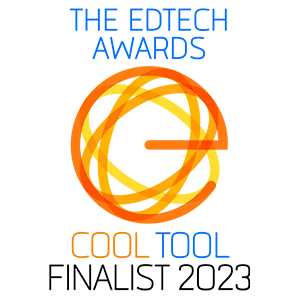
2023 EdTech Awards Cool Tool Finalist

Tech & Learning Awards of Excellence Best of 2022

The Tech Edvocate Awards 2022

Parent and Teacher Choice Award

2022 EdTech Awards Cool Tool Finalist
Frequently Asked Questions (FAQs)
When should I start using an SAT prep course?
Most students begin using an online SAT prep course 3–6 months before their test date. With our adaptive online SAT prep course, you can start anytime and move at your own pace – making study time more efficient than traditional SAT test prep. UWorld’s online SAT prep course is designed for the digital SAT and can be used year-round or as a focused digital SAT crash course over school breaks. Starting sophomore year or early junior year gives you time to take the digital SAT more than once if needed.
What’s included in UWorld’s SAT prep course?
UWorld’s all-in-one SAT exam preparation course includes:
- Expert-taught video lessons covering every test topic
- 1,650+ realistic SAT practice questions with illustrated explanations
- Interactive study guide (print + digital) with 400+ knowledge checks
- Score-predicting full-length mock test
- Built-in Desmos graphing calculator
- Customizable quiz generator and adjustable study planner
- Progress tracking dashboard with performance analytics
- Smart flashcards with spaced repetition
- Mobile app access (iOS and Android) with offline mode.
All features work together for a complete, flexible SAT study experience.
What makes UWorld's online SAT prep course different?
UWorld’s SAT prep course blends expert instruction, engaging visuals, and adaptive technology for a smarter learning experience. Our proven Watch → Read → Practice method ensures lasting mastery:
Watch short, focused video lessons from experienced instructors – no boring, lengthy lectures. Get shortcuts to math questions plus strategies and tips you can use immediately on the digital SAT.
Read interactive prep guides with colorful illustrations and knowledge checks that reinforce key SAT concepts.
Practice with questions just like the real SAT exam in a test interface that mirrors the actual digital SAT. Our online SAT prep course lets you create custom practice tests based on difficulty level and your target test score.
Track Progress with detailed analytics that show you exactly where you need to improve, so you can focus your SAT prep course study time efficiently.
The platform adapts to your progress with instant feedback and detailed explanations for every question. This online SAT prep course includes full mobile access for studying anytime, anywhere – like having a personal digital SAT tutor available 24/7.
Does your online SAT prep course mirror the actual SAT exam?
Absolutely! UWorld’s online SAT prep course fully replicates the digital SAT format. Our SAT prep course provides the most authentic digital SAT practice experience available:
Adaptive Testing Just Like the Real Digital SAT
- Module 2 automatically adjusts difficulty based on your Module 1 performance
- Experience the exact same adaptive algorithm used on test day
Identical Test Interface
- Mirrors the official Bluebook testing platform
- Built-in Desmos graphing calculator for all math questions
- Split-screen reading tools with digital annotation features
Exact Timing and Structure
- Two Math modules with the same time limits as the real SAT exam
- Two Reading & Writing modules matching actual digital SAT format
- Practice tests that replicate test day conditions perfectly
Questions Just Like the Real SAT Exam
- Every question in our online SAT prep course reflects actual digital SAT difficulty and style
- No surprises on test day – you’ll know exactly what to expect
With UWorld’s SAT prep course, you’ll practice in the same environment you’ll experience on the actual digital SAT, building confidence and familiarity before test day.
How will this SAT course improve my score?
UWorld’s SAT exam preparation course is built around an adaptive Watch → Read → Practice model designed to help you learn faster and retain more.
You’ll begin by watching short, focused video lessons that simplify complex topics, then read interactive study guides that reinforce key concepts. Finally, you’ll practice with realistic, exam-style questions that provide detailed explanations for every answer choice.
The platform automatically tracks your performance and adjusts difficulty based on your progress, ensuring that you focus where improvement matters most. Consistent use for 4–8 weeks typically leads to 200–300 point increases – boosting both confidence and performance on test day.
Can I access the SAT course materials anytime?
Yes! All of UWorld’s SAT exam preparation course materials are available 24/7 across all devices.
Whether you’re practicing questions, watching video lessons, or reviewing study guides, your progress automatically saves so you can continue exactly where you left off.
This flexibility allows you to fit your SAT study course into any schedule – whether you prefer to study early in the morning, late at night, or whenever it’s most convenient.
How does UWorld compare to private SAT tutoring or local classes?
UWorld does not offer live SAT tutoring, but it delivers the same expert guidance and personalized support—at a fraction of the cost.
Private SAT tutors often charge $100–$300 per hour (or $2,000–$6,000 total). In contrast, UWorld’s full-access SAT course costs $249–$399 for up to a year – delivering expert guidance without scheduling hassles or high fees.
You’ll get on-demand video lessons available 24/7, adaptive quizzes that automatically target your weak areas, and a real-time analytics dashboard to track your progress.
UWorld combines the quality of tutoring, the structure of a class, and the flexibility of online learning, giving you everything you need to raise your score efficiently.
Do you offer SAT crash courses?
Yes! Our 30-day Introductory Plan works as a focused SAT crash course, featuring high-yield review videos, adaptive quizzes targeting weak areas, and a full-length score-predicting mock test. Even a few weeks of intensive, focused practice can produce significant score gains for students with limited preparation time.
How do I track my SAT review progress?
UWorld’s analytics dashboard gives you a clear picture of your performance at every stage of your SAT study course. You can track progress by subject area, question type, and difficulty level, helping you pinpoint exactly where to focus next.
Interactive charts display your score growth over time, while performance analytics highlight strengths, weaknesses, and improvement trends.
This detailed feedback keeps you motivated and ensures that every study session moves you closer to your target score.
Are your SAT test review materials up to date?
Yes. UWorld’s SAT test prep courses are continually updated to reflect the latest Digital SAT (DSAT) format and testing experience.
Our materials mirror the official Bluebook exam environment, including adaptive modules, accurate timing, the built-in Desmos graphing calculator, and digital tools used on test day. Every question and feature is designed to ensure 100% exam relevance and accuracy, so you can study with total confidence knowing your preparation matches the real SAT.
Are there free SAT prep courses that actually work?
Yes, there are several free SAT preparation courses, such as Khan Academy’s partnership with the College Board. These are excellent for learning the basics, reviewing key concepts, and practicing foundational question types.
However, most free SAT prep programs don’t include advanced tools like adaptive learning, predictive score analytics, or structured progress tracking, which are crucial for large score improvements.
That’s why UWorld offers a 7-day free trial of its full online SAT preparation course. During your trial, you’ll experience the same adaptive quizzes, video lessons, and detailed explanations found in the paid plans. Many students start with free practice tools and then use UWorld’s structured, adaptive SAT study course for deeper mastery and faster score growth.
How does UWorld compare to Khan Academy?
Khan Academy provides free materials for building foundational SAT skills. But once you’ve mastered the basics, UWorld’s SAT exam preparation course takes you to the next level with deeper content, exam-like practice, and advanced analytics.
UWorld offers:
- 1,650+ Digital SAT-style practice questions with detailed, illustrated explanations
- Adaptive quizzes and performance analytics to target weak areas
- Expert video lessons aligned with SAT test objectives
- Print + digital study guides for flexible review
That’s why many students start with Khan Academy to learn the basics, then switch to UWorld for advanced, adaptive practice that leads to faster score growth.
What should I look for in an SAT math course, and how does UWorld compare?
A great SAT math course should cover every domain tested on the exam – Algebra, Advanced Math, Problem Solving & Data Analysis, and Geometry/Trigonometry – with clear explanations, progressive difficulty, and adaptive feedback.
UWorld’s SAT math review includes:
- Step-by-step video lessons for every math concept
- 750+ targeted math questions with visual solutions
- 400+ interactive knowledge checks
- Adaptive quizzes that adjust difficulty to your performance
Whether you’re struggling with algebra or fine-tuning for a perfect 800, UWorld’s SAT math prep course helps you build accuracy, speed, and confidence through guided, efficient practice.
Does UWorld’s course teach SAT Reading (grammar and writing skills)?
Absolutely. UWorld’s SAT exam prep course includes a full writing and grammar module covering all conventions tested on the SAT – sentence boundaries, verb tense, pronoun use, punctuation, modifiers, and transitions.
Interactive examples and visual explanations show how grammar rules apply in real test contexts. You’ll learn to identify common traps, understand error patterns, and improve accuracy through guided practice.
How does UWorld’s course help with SAT vocabulary?
UWorld focuses on context-based vocabulary mastery rather than rote memorization. Lessons teach you to interpret meaning from context, tone, and structure – the exact skills needed for the Digital SAT Reading and Writing section.
Smart flashcards and realistic passages help you learn high-frequency SAT words naturally while improving reading comprehension and writing precision.
Can I customize the course to focus on specific SAT sections?
Yes! UWorld’s online SAT preparation course lets you create personalized study paths. You can focus exclusively on Math or Reading & Writing, or mix both.
Your dashboard tracks results by topic and automatically generates targeted quizzes on weaker areas—making every study session more effective.
Does UWorld’s SAT course work for all score levels?
Yes. Whether you’re just beginning your SAT prep or targeting a perfect 1600, UWorld’s SAT study course adapts to your performance level.
Its analytics dashboard highlights strengths and weaknesses, so you can improve strategically at any stage of your test-prep journey
Meet Our Expert SAT Teachers

27 years teaching high school English, including 16 years for AP® English Language
Advanced rhetorical analysis, argumentative writing, and college-level literary skills
Creates study materials for the SAT and ACT exams

37 years teaching high school English, including 23 years for AP English Literature
In-depth knowledge of literature, language, and skills needed for academic success
Has a Bachelor of Arts in English and a master’s in Humanities; creates study materials for the SAT and ACT exams


25+ years tutoring students for the SAT and ACT®, and 10 years as an SAT essay grader for the College Board®
High-school English, GED classes, and college-level composition classes
Has a Bachelor of Arts in English with a specialization in Creative Writing and a Master of Arts in English as a Second Language


13 years tutoring high-school students in English and math
SAT and ACT preparation, testing strategies, and a focus on helping students strengthen their academic foundation
Creates study materials for both the SAT and ACT exams

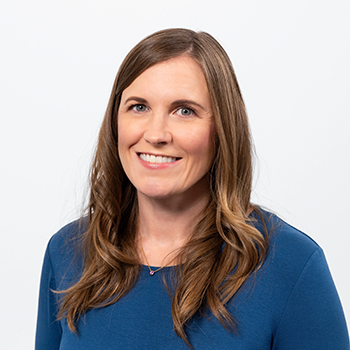
22 years in math education — classrooms and educational tech startups
Pedagogy and addressing students’ needs in math through traditional and innovative solutions
Has a Bachelor of Science in Applied Mathematical Sciences and a Master of Arts in Mathematics


10 years in engineering, and 12 years teaching high-school math
Technical and instructional disciplines by applying math to the SAT and ACT in preparation for future technical studies
Has a Bachelor of Science in Mechanical Engineering and Master of Science in Engineering

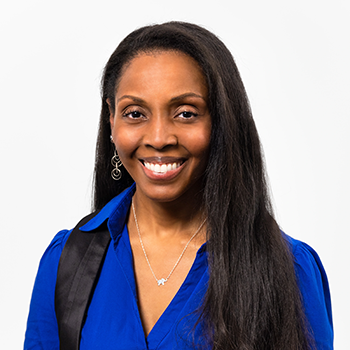
20 years in math education, ranging from Algebra I to AP Calculus, and curriculum writing at both district and state levels
Pedagogy with real-world testing standards to prepare students for the SAT, ACT, AP Calculus, and AP Statistics
Has a master's in Education and has completed doctoral coursework

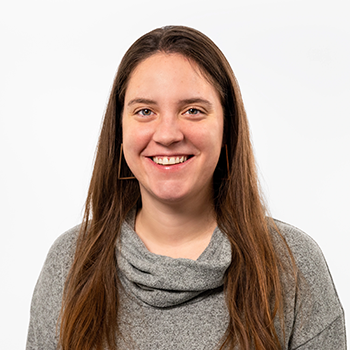
10+ years in SAT/ACT math content development, and 4 years teaching underperforming students
Adaptable and diverse math teaching methods that help students across skill levels
Has a dual degree in Philosophy and Mathematics

|
UWorld
Full Course
|
Prep Scholar
Complete Online Prep
|
Princeton Review
Self-Paced
|
Kaplan
On-Demand Course
|
||
|---|---|---|---|---|---|
| Essential Course Features | |||||
| Essential Course Features | |||||
|
Length of Online Access
|
Starting at 30 days | 1 year only | 1 year only | 6 months only | |
|
Video Lessons
|
|||||
|
Practice Questions
|
|||||
|
Prep Book Set
|
|||||
|
Predictive SAT Mock Test
|
|||||
| Enhanced Product Features | |||||
| Enhanced Product Features | |||||
|
Mobile App
|
|||||
|
Free Trial
|
|||||
|
Study Plans
|
|||||
|
Realistic Test Simulation
|
|||||
|
Digital Calculator
|
|||||
|
Quiz Generator
& Customizable Practice
|
|||||
|
Diagnostic Reporting
|
|||||
